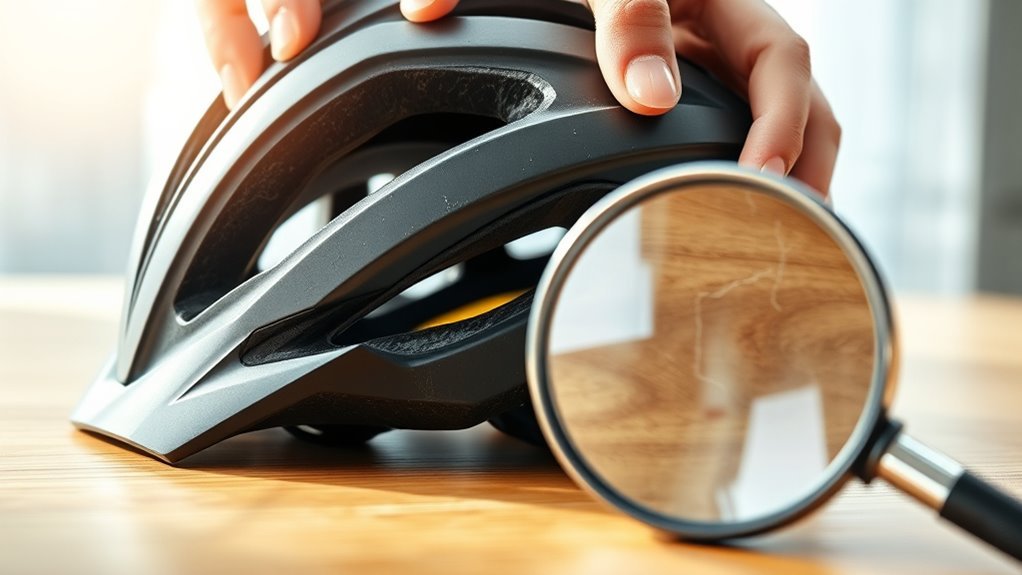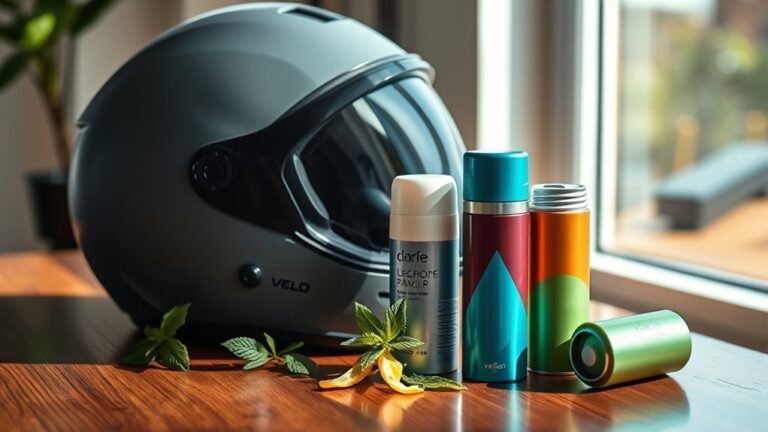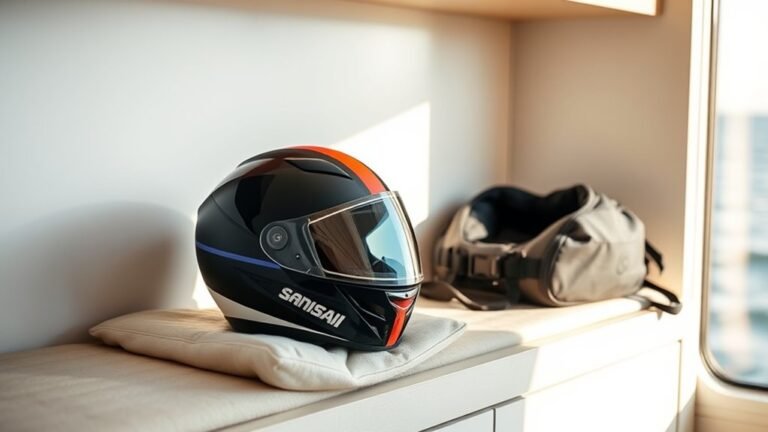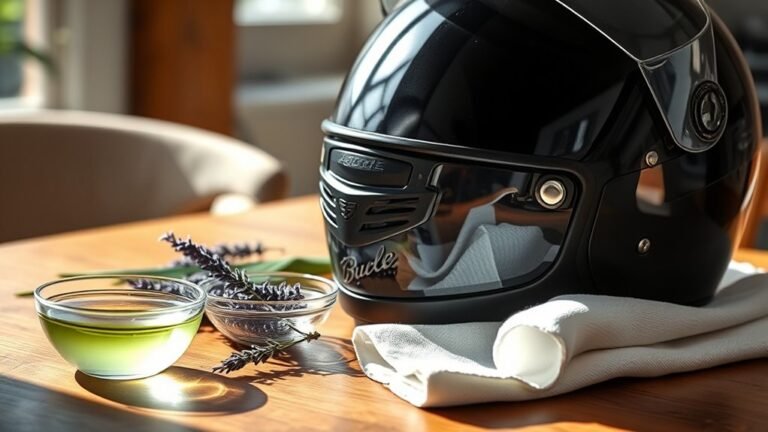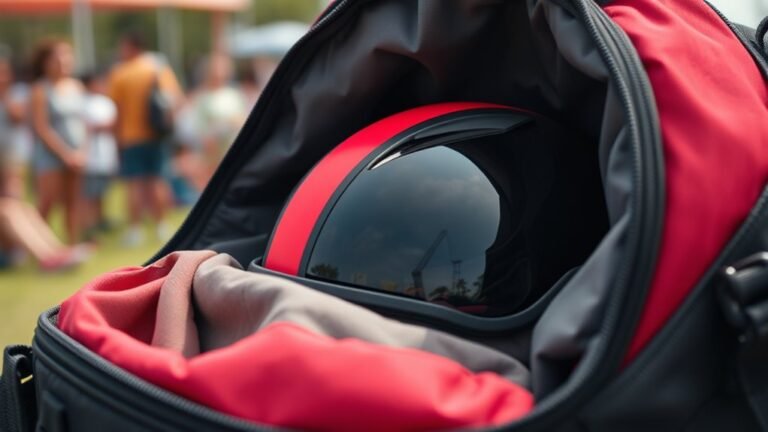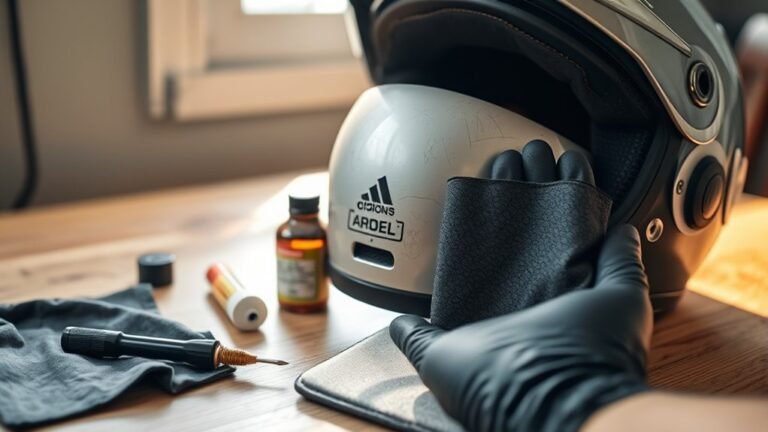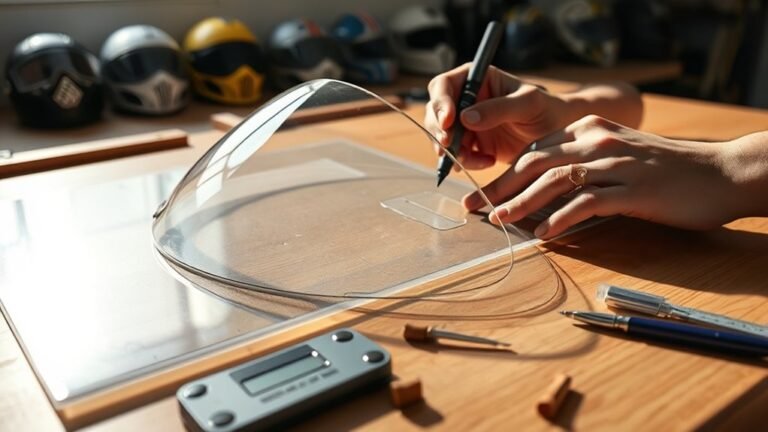How to Check Your Helmet for Hidden Damage
To check your helmet for hidden damage, start by inspecting the outer shell for cracks or dents. Peek inside to examine the liner for tears, moisture, and strange odors. Make sure the straps and buckles are secure and functioning properly. Watch for wear indicators like fading or compression. If your helmet is over five years old or shows signs of damage, it’s time to replace it. Keep on to learn more about maintaining your helmet’s safety.
Understanding the Importance of Helmet Safety
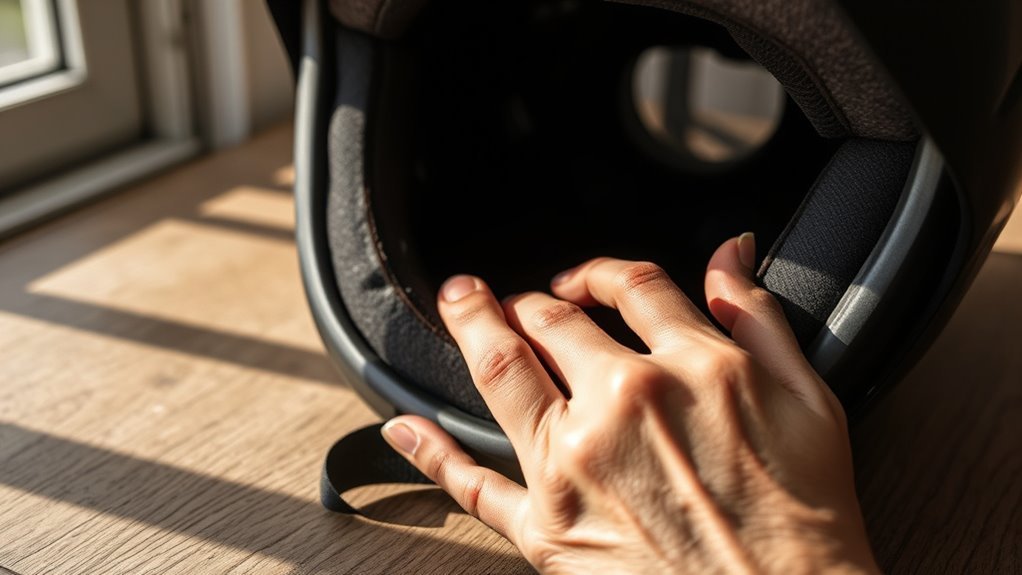
Helmet safety is vital for protecting your head during sports or activities that pose a risk of injury. Understanding helmet effectiveness means recognizing how well a helmet absorbs impact and prevents injuries. Helmets that meet safety standards are rigorously tested to guarantee they can withstand significant forces, providing peace of mind when you’re out on the field or the road. Choosing a helmet that complies with these standards is essential for maximizing your safety. It’s not just about looking cool; it’s about safeguarding your freedom to enjoy your favorite activities without the looming threat of head injury. Remember, a well-chosen helmet can be the difference between a minor bump and a life-altering accident. Prioritize your safety by selecting the right helmet.
Inspecting the Outer Shell for Cracks and Dents
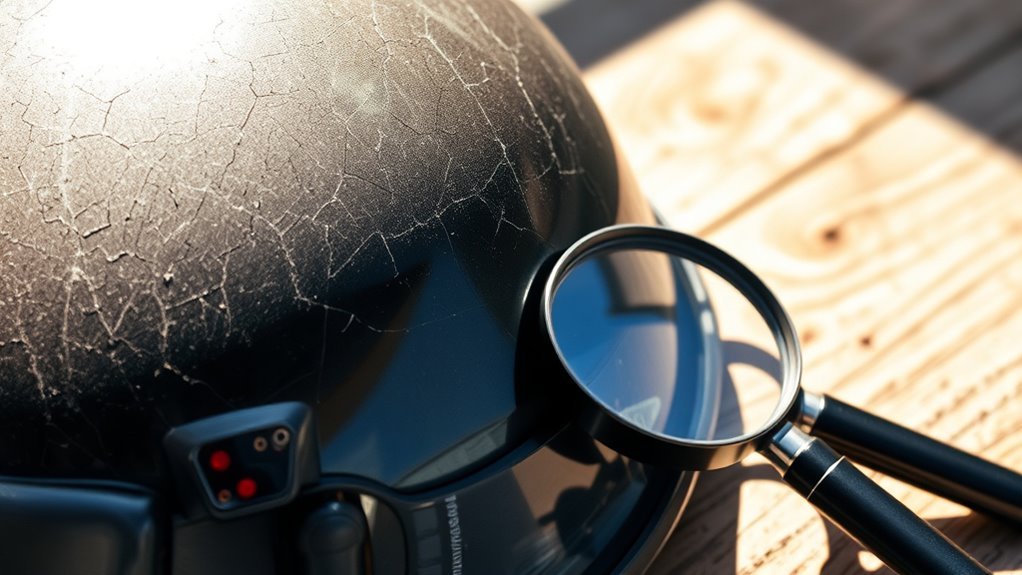
When inspecting your helmet, start by looking for visible cracks and dents on the outer shell. These imperfections can compromise its protective capabilities. Make sure the surface feels smooth and intact, as any irregularities might indicate hidden damage.
Examine for Visible Damage
A thorough inspection of your helmet’s outer shell is essential for ensuring its safety and effectiveness. Look closely for any visible damage, as hidden impacts can compromise its structural integrity. Cracks and dents may not always be obvious but can indicate serious issues.
| Damage Type | Action Needed |
|---|---|
| Surface Cracks | Replace the helmet |
| Dents | Inspect further |
| Scratches | Monitor for deep flaws |
| Paint Chips | Assess underlying damage |
| No Visible Damage | Regular check recommended |
Check for Surface Integrity
To guarantee your helmet remains reliable, checking for surface integrity is essential. Regular inspections can reveal hidden dangers linked to surface wear and material degradation. Here’s what to look for:
- Cracks: Inspect the outer shell for any visible fractures, which can compromise safety.
- Dents: Look for any indentations that may indicate impact damage, affecting the helmet’s protective capabilities.
- Discoloration: Watch for fading or uneven coloring, which can suggest age-related material degradation.
Checking the Interior Liner for Damage
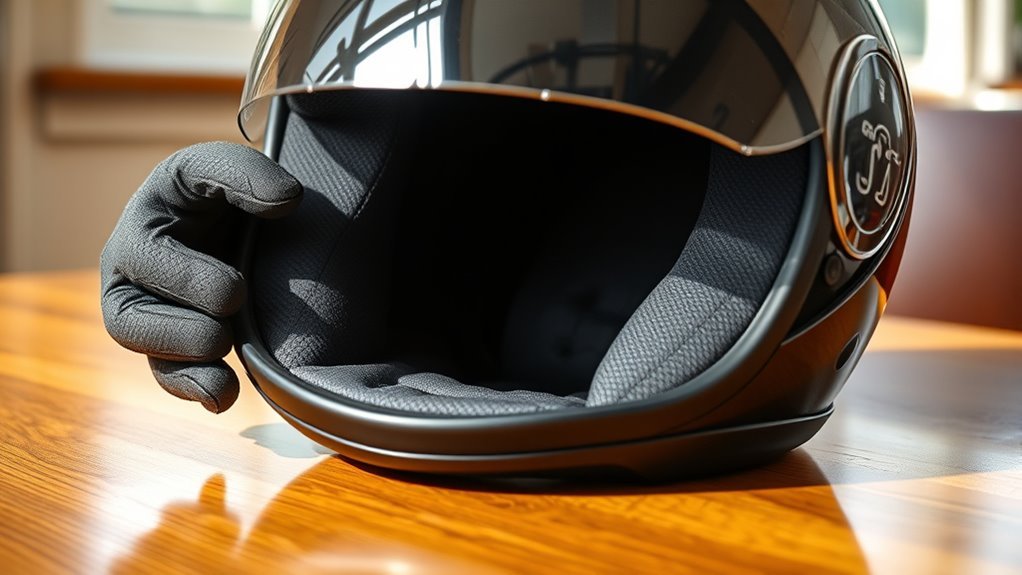
Since the interior liner of your helmet plays a crucial role in absorbing impact, it’s important to inspect it regularly for signs of damage. Start by removing the interior padding and examining it closely for cracks or tears. Look for any signs of moisture accumulation, which can weaken the foam over time and lead to reduced effectiveness. If you notice any funky odors, it may indicate mold or mildew growth, suggesting it’s time for a replacement. Also, feel for any unusual hard spots that could compromise your helmet’s safety. Regular checks keep your helmet in prime condition, ensuring you have the freedom to ride without worrying about hidden damage. Remember, safety first!
Evaluating the Straps and Buckles
After checking the interior liner, it’s time to focus on the straps and buckles that keep your helmet securely in place. Ensuring these components are in top shape is essential for your safety and comfort.
- Strap Tension: Pull on the straps to test their tension. They should feel snug but not uncomfortably tight, allowing for a proper fit.
- Buckle Functionality: Examine the buckle for any signs of wear or damage. It should click securely and release easily when needed.
- Adjustments: Make sure all adjustments work smoothly. If any part feels stiff or broken, it’s time to replace them.
Taking a moment to evaluate your straps and buckles can make all the difference in your riding experience.
Recognizing Signs of Wear Over Time
While you may not notice it immediately, helmets can wear down over time, which can compromise their effectiveness. To guarantee your helmet’s safety, keep an eye out for wear indicators like cracks, dents, or discoloration. These signs can hint at reduced protection levels. Regularly assess the padding; if it’s compressed or deteriorating, it’s time to reflect on its longevity assessment. Check for any fading or peeling of the outer shell, as this could signal exposure to elements that weaken the material. Furthermore, verify the interior foam is intact. Maintaining awareness of these nuances not only prolongs your helmet’s life but also safeguards your freedom to ride with confidence. Stay vigilant and prioritize your safety on every adventure.
Knowing When to Replace Your Helmet
Knowing when to replace your helmet is essential for ensuring your safety on the road. Several helmet lifespan factors can help you determine the right time for a replacement. Follow these replacement guidelines:
- Age: If your helmet’s more than five years old, it’s time for a new one.
- Damage: Any cracks, dents, or worn-out padding means your helmet’s lost its effectiveness.
- Impact: If you’ve been in an accident, even a minor one, replace your helmet immediately.
Frequently Asked Questions
Can I Clean My Helmet Without Damaging It?
Yes, you can clean your helmet without damaging it. For proper helmet care, use mild soap and warm water with a soft cloth. Avoid harsh chemicals or abrasive materials, as they can harm the helmet’s surface. Focus on the inside padding, too—remove it if possible and wash it separately. Always let your helmet air dry completely before using it again. Following these cleaning methods will keep your helmet in top shape and extend its lifespan.
How Often Should I Inspect My Helmet for Damage?
You should inspect your helmet for damage every six months to guarantee safety and extend its lifespan. Frequent inspections foster fantastic awareness of your helmet’s condition. Look for cracks, dents, or discoloration during these checks. If you ride often, consider checking more regularly—perhaps monthly. Remember, a well-maintained helmet can be your best ally in adventure, keeping you free and protected on the open road or trail. Safety’s key!
What Should I Do if My Helmet Has Been Dropped?
If your helmet’s been dropped, it’s essential to check for damage. Even if it looks fine, a drop can cause hidden damage that compromises helmet safety. Inspect for cracks, dents, or any deformities. If you notice anything unusual, replace the helmet immediately, as the drop impact might’ve weakened its protective capabilities. Remember, your safety depends on a reliable helmet, so don’t take any chances—better safe than sorry!
Are There Specific Brands Known for Better Durability?
Yes, there are specific brands known for better durability. When you’re looking at brand comparisons, consider options like Bell, Shoei, and Arai, which often receive high durability ratings. These manufacturers prioritize quality materials and construction techniques, ensuring your helmet can withstand impacts and wear over time. Always check for user reviews and safety certifications, as they provide insight into a helmet’s performance and longevity, helping you make a more informed choice.
Can I Repair a Damaged Helmet Instead of Replacing It?
Trying to repair a damaged helmet is like patching a sail; it might hold for a while, but safety’s vital. While some repair techniques exist, they often can’t restore the helmet’s original integrity. Remember, a helmet’s lifespan is designed with safety in mind, and any damage can compromise that. It’s usually best to replace it instead of risking your safety for a temporary fix. Prioritize your freedom to ride safely.
